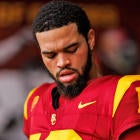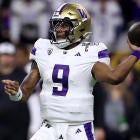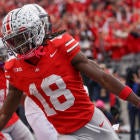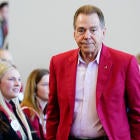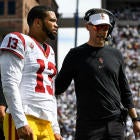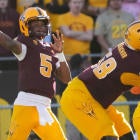In a significant opinion from the Ed O’Bannon case, the US Ninth Circuit Court of Appeals upheld a lower court's decision that NCAA rules restricting payment to college athletes violate antitrust laws, but also determined that a federal judge erroneously allowed players to be paid up to $5,000 per year in deferred compensation.
The panel vacated US District Judge Claudia Wilken's injunction from August 2014 related to athletes receiving extra compensation for the use of their names, images and likenesses. The Ninth Circuit upheld Wilken's ruling giving schools the choice to give athletes scholarships that cover the full cost of attendance -- money that is currently being applied throughout college sports.
"The NCAA is not above the antitrust laws, and courts cannot and must not shy away from requiring the NCAA to play by the Sherman Act's rules," the three-person panel wrote. "In this case, the NCAA's rules have been more restrictive than necessary to maintain its tradition of amateurism in support of the college sports market. The Rule of Reason requires that the NCAA permit its schools to provide up to the cost of attendance to their student athletes. It does not require more."
The NCAA won a victory by avoiding Wilken's injunction that would have allowed deferred payments to players. But the appellate decision related to antitrust laws could set the stage for the NCAA to attempt to appeal O'Bannon to the Supreme Court. The Ninth Circuit disagreed with the NCAA's interpretation of a 1984 Supreme Court decision that the association has used as a defense for decades in relation to its amateurism rules.
The opinion, written by Judge Jay Bybee, offered support to the NCAA’s amateurism principles. “The difference between offering student-athletes education-related compensation and offering them cash sums untethered to educational expenses is not minor; it is a quantum leap,” the opinion stated. “Once that line is crossed, we see no basis for returning to a rule of amateurism and no defined stopping point; we have little doubt that plaintiffs will continue to challenge the arbitrary limit imposed by the district court until they have captured the full value of their (names, images and likenesses). At that point the NCAA will have surrendered its amateurism principles entirely and transitioned from its 'particular brand of football' to minor league status.”
The opinion also stressed “we wish to emphasize the limited scope of the decision that we have reached,” meaning invalidating Wilken’s plan to allow NCAA schools to pay athletes up to $5,000. The panel wrote that “in finding that paying students cash compensation would promote amateurism as effectively as not paying them, the district court ignored that not paying student-athletes is precisely what makes them amateurs.”
Chief Judge Sidney Thomas concurred in part and dissented in part with the opinion. He disagreed with the majority’s conclusion that Wilken erred in ordering the NCAA to permit up to $5,000 in deferred payment for use of athletes’ names, images and likenesses (NILs).
Rutgers law professor Michael Carrier, who has closely followed the case for years, said the O'Bannon plaintiffs got very strong rulings that NCAA amateurism rules are subject to antitrust scrutiny, meaning future challenges of NCAA rules can still exist. The NCAA, meanwhile, got a "strong win" on the issue of NILs that will make it hard for the Shawne Alston and Martin Jenkins lawsuits that seek the allowance of money above cost of attendance for college athletes, Carrier said. The Jenkins case, led by attorney Jeffrey Kessler, wants a free market for football and men's basketball players and has a class certification hearing along with Alston on Thursday before Wilken.
"Not only did the Ninth Circuit strike this down but it did so in a way that makes it hard to see how (if upheld) future attempts to get even more money for students (like in Alston and Jenkins) would be successful," Carrier wrote via email. "If even this deferred $5K doesn't fly, nor would greater amounts that have even less to do with educational expenses."
Steve Berman, the lead attorney for the Alston plaintiffs, said the O'Bannon ruling strengthens his damages case seeking past money for decades of the NCAA restricting cost of attendance payments. "If we get it certified, it will be a slam dunk on damages," Berman said.
Berman said the uncertain question is whether the Alston/Jenkins plaintiffs can force the NCAA to allow compensation above the cost of attendance. Berman cited a footnote from the Ninth Circuit that said “there is little evidence in the record about the impact of $5,000 NIL payments. There is evidence only that small payments will be less harmful than larger payments, and that a single witness would not be as trouble by $5,000 payments.”
Said Berman:"The NCAA is going to say the opinion says you can absolutely not go above cost of attendance. I don't read the opinion that way. We believe we can develop a record that shows payments above cost of attendance will meet that standard. If we can show that consumers are kind of angry about the disparity between what coaches and schools make versus what players make and that action actually enhances consumer demand, I think we can win."
Berman said he and Kessler are "on the same page" to develop a record that shows cash payments are OK. Where they disagree, Berman said, is Kessler wants no rules on how to pay players and Berman wants rules at the conference level that would allow cash payments. Kessler declined to comment Wednesday.
"Our theory is each conference would set its own compensation rules, and as a matter of economics, the conferences would be restrained to the extent they worry paying too much would hurt consumer demand," Berman said.
Panel disagrees with NCAA on Board of Regents
“But we are not bound by Board of Regents to conclude that every NCAA rule that somehow relates to amateurism is automatically valid,” the appellate judges wrote. “What is more, even if the language in Board of Regents addressing amateurism were not dicta, it would not support the tremendous weight that the NCAA seeks to place upon it.”
The appellate judges wrote that that they “accept Board of Regents’ guidance as informative with respect to the pro competitive purposes served by the NCAA’s amateurism rules, but we will go no further than that. The amateurism rules’ validity must be proved, not presumed.”
In the opinion, the panel acknowledged that “the Board of Regents Court certainly discussed the NCAA’s amateurism rules at great length, but it did not do so in order to pass upon the rules’ merits, given that they were not before the Court. Rather, the Court discussed the amateurism rules for a different and particular purpose: to explain why NCAA rules should be analyzed under the Rule of Reason, rather than held to be illegal per se. The point was a significant one.”
The appellate judges wrote that the 1984 Supreme Court case “did not approve the NCAA’s amateurism rules as categorically consistent with the Sherman Act. Rather, it held that, because many NCAA rules (among them, the amateurism rules) are part of the ‘character and quality of the [NCAA’s] product … no NCAA rule should be invalidated without a Rule of Reason analysis. The Court’s long encomium to amateurism, though impressive-sounding, was therefore dicta.”
The opinion could set up an attempt by the NCAA or the O'Bannon plaintiffs to have O'Bannon heard before the Supreme Court. NCAA chief legal officer Donald Remy said it's not clear yet what impact the O'Bannon appellate decision will have on the Kessler and Alston cases.
On a conference call with reporters, NCAA leaders expressed satisfaction with some of the O'Bannon opinion, particularly the elimination of the allowance of $5,000 per year to athletes.
"I think the ruling does provide greater clarity on a number of fronts," NCAA president Mark Emmert said. "… The fundamental notion of pay for play, as it’s often referred to, is at odds with the notion of amateurism and at odds with the fundamental underpinnings of collegiate athletics. The ruling has those statements in there in pretty direct language. I hope that will, in some ways limit some of the legal arguments that are being made.”
Big 12 commissioner Bob Bowlsby said the decision "provides some level of uncertainty but also a welcome level of certainty. I think it's the affirmation of our belief that these are students and this is an educational enterprise. Even though it has some elements that look like business, these are not employees, these are students."
Remy said it's too soon to determine if the NCAA will try to appeal portions of the Ninth Circuit's decision to the Supreme Court or seek an en banc review before all of the Ninth Circuit's judges instead of a panel. NCAA attorney Seth Waxman said the O’Bannon ruling creates “flat conflict” with decisions in other circuits and strengthens the NCAA’s possible bid for a Supreme Court review.
Waxman noted that the Ninth Circuit acknowledged that it was creating a circuit split with the Seventh Circuit over the 1984 Board of Regents ruling in Agnew v. NCAA. That case involved former college football players challenging the NCAA's rules on prohibiting multi-year scholarships and capping the number per team. The Ninth Circuit opinion stated that only the Seventh Circuit "comes close to agreeing with the NCAA's interpretation of Board of Regents, and we find it unpersuasive."
O'Bannon attorney Michael Hausfeld said he was "thrilled" with the decision and has no interest appealing to the Supreme Court. He noted that it was Wilken's idea to allow $5,000 per year to players, not O'Bannon's.
"I think this is an even worse position than the NCAA has been in," Hausfeld said. "Remember, the court did not strike down the unlawfulness of the regulation. They just said the relief wasn't necessarily a less-restrictive restraint. So is there other relief? Now they've opened it up to us to propose reforms of relief. This opinion shakes up the entirety of the relationship that the NCAA has had with the athletes. They can no longer exercise economic dominion over athletes’ values. it clearly underscores the responsibility of the schools and the association to make sure athletic participation does not diminish academic success."
Hausfeld is also the attorney in the Rashanda McCants lawsuit against the NCAA and North Carolina over the academic fraud scandal at UNC. Hausfeld said the O'Bannon ruling will help him in McCants.
"In McCants, the NCAA says they have no obligation to academics," Hausfeld said. "This court says that's your very reason for existing."
Elsewhere in the Ninth Circuit's opinion
* Two of the three judges disagreed with an expert for O’Bannon who showed the public continued to watch baseball despite opinion surveys opposing rising baseball salaries, and the public still watched the Olympics with professional athletes. “But professional baseball and the Olympics are not fit analogs to college sports,” the panel wrote. “The Olympics have not been nearly as transformed by the introduction of professionalism as college sports would be.”
The lack of a strong rebuttal study by the O'Bannon plaintiffs was cited during the trial and may have played a role in the decision. The consumer demand language by the Ninth Circuit could impact the Kessler case, which would need to show consumer demand wouldn't be impacted by athletes getting paid in a free market.
* Two of the three judges wrote that an “offhand comment” by former CBS Sports president Neal Pilson appears to be the only reason for Wilken’s $5,000 figure. At the O’Bannon trial, Pilson was asked under cross-examination whether there was a line that should not be crossed in paying players, and eventually commented that “a million dollars would trouble me and $5,000 wouldn’t, but that’s a pretty good range.”
However, the majority opinion determined Pilson made clear he was not prepared to give an opinion on whether pure cash compensation would affect amateurism and his “casual comment” is not enough to reach Wilken’s “far-reaching conclusion” that paying athletes $5,000 per year will be as effective at preserving amateurism as the NCAA’s current policy. Thomas, the chief judge, said Pilson was a credible expert for the NCAA whose comments supported the O'Bannon plaintiffs' position.
* Thomas disagreed with the majority opinion that courts should determine the difference between amateur and professional sports. “It is a line for consumers to draw,” he wrote. “If consumers believe that paying college football players $5,000 to be held in trust for use of their (names, images and likenesses) will convert college football into professional football, and as a consequence they stop watching college football, then the proposed alternative will not be virtually as effective as the current rule.” Thomas wrote that the idea that "'if you're paid for performance, you're not an amateur' ... does not reflect consumer behavior."
* The appellate court rejected the NCAA’s argument that its rules preventing compensation aren’t subject to antitrust law. “The NCAA’s argument that its compensation rules are ‘eligibility’ restrictions, rather than substantive restrictions on the price terms of recruiting agreements, is but a sleight of hand,” the panel wrote. “There is real money at issue here.”
* The Ninth Circuit disagreed with the NCAA’s argument that its rules preventing athletes from being paid makes college sports more attractive to recruits. “Nothing in the plaintiffs’ prayer for compensation would make student-athletes something other than students and thereby impair their ability to become student-athletes,” the panel wrote. “Indeed, if anything, loosening or abandoning the compensation rules might be the best way to ‘widen’ recruits’ range of choices; athletes might well be more likely to attend college, and stay there longer, if they knew that they were earning some sort of (names, images and likenesses) income while they were in school.”
* The panel agreed with Wilken’s conclusion that the NCAA’s commitment to amateurism is a “concrete” procompetitive effect and increases college sports’ appeal to consumers.
* The panel agreed that the O’Bannon plaintiffs showed they were injured for not being able to get paid for appearing in video games. But they judges said they did not tackle the “thornier questions” of whether athletes on live TV broadcasts have enforceable rights of publicity.
Follow and read more from Jon Solomon on Facebook and Twitter.












